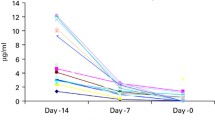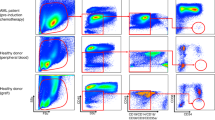Abstract
A single dose of rabbit antithymocyte globlin (ATG) was given as the sole immunosuppressive therapy in a model of strong MHC barrier rat heart allotransplantation. PVG/c hearts transplanted to Wistar/Kyoto (WKy) rats resulted in long-term surviving (LTS) grafts and cellmediated lympholysis (CML) unresponsiveness in 50% of the animals. The effects of ATG treatment on the peripheral blood lymphocyte subsets were studied by flow cytometry. The absolute T-lymphocyte levels decreased to less than 5% and were normalized after 2 weeks. CD8-positive cells were normalized within 1 week, whereas CD4- and CD5-positive cells remained low. Rats with LTS grafts had low levels of all T-lymphocyte markers, especially the CD4- and CD5-positive cells. Rats rejecting their grafts showed an eightfold increase in levels of CD8- and CD5-positive lymphocytes and a twofold increase in levels of CD4-expressing lymphocytes. It is concluded that ATG treatment causes the immediate elimination of large lymphoid populations as well as long-lasting immunomodulation detectable in peripheral blood.
Similar content being viewed by others
References
Claesson K, Klareskog L, Larsson P, Holmdahl R, Forsum U, Scheynius A, Tufveson G (1987) Effects of monoclonal anti-T cell antibodies on rat cardiac allografts. Scand J Immunol 26: 337–345
Cobbold SP, Martin G, Qin S, Waldmann H (1986) Monoclonal antibodies to promote marrow engraftment and tissue graft tolerance. Nature 323: 164–166
Fabre JW, Sunderland CA, Williams AF (1980) Immunosuppressive properties of rabbit antibodies against a major glycoprotein restricted to rat leukocyte membranes. Transplantation 30: 167–173
Herbert J, Roser B (1988) Strategies of monoclonal antibody therapy that induce permanent tolerance of organ transplants. Transplantation 46: 128–134S
Kilshaw PJ, Brent L, Thomas AV (1974) Specific unresponsiveness to skin allograft in mice. II. The mechanism of unresponsiveness induced by tissue extracts and antilymphocytic serum. Transplantation 17: 57–69
Lance EM, Medawar P (1969) Quantitative studies on tissue transplantation immunity. IX. Induction of tolernace with antilymphocytic serum. Proc R Soc London [Biol] 173: 447–473
Mahdi NA, Hutchinson IV, Brent L (1983) Specific unresponsiveness to fully allogeneic kidney allografts in rats induced by procarbazine hydrochloride and antilymphocyte serum. Transplantation 36: 480–485
McAteer MJ, Lagarde A-C, Georgiou H, Bellgrau D (1988) A requirement for the CD-5 antigen in T-cell activation. Eur J Imunol 18: 1111–1117
Mjörnstedt L, Olausson M, Hedman L, Lindholm L, Brynger H (1984) Induction of long-term heart allograft survival in the rat by ATG. Int Arch Allergy Appl Immunol 74: 193–199
Olausson M, Mjörnstedt L, Lindholm L, Brynger H (1984) Nonsuture organ grafting to the neck vessels in rats. Acta Chir Scand 150: 463–467
Olausson M, Mjörnstedt L, Wramner L, Lindholm L, Söderström T, Brynger H (1988) Characteristics of the induction phase of antithymocyte globulin induced heart allograft tolerance in the rat. Int Arch Allergy Appl Immunol 86: 131–138
Roser BJ (1989) Cellular mechanisms in neonatal and adult tolerance. Immunol Rev 107: 179–202
Starzl TE, Marchioro TL, Porter KA, Iwasaki Y, Cerilli GJ (1967) The use of heterologous antilymphoid agents in canine renal and liver homotransplantation and in human renal homotransplantation. Surg Gynecol Obstet 124: 301–318
Thompson SC, Bowen KM, Burton RC (1987) The effect of immunosuppressive agents on lymphocyte subsets in rat peripheral blood. Int J Immunopharmacol 9: 747–759
Waldmann H (1989) Manipulation of T-cell responses with monoclonal antibodies. Ann Rev Immunol 7: 407–444
Wramner L, Olausson M, Mjörnstedt L, Söderström T, Brynger H (1988) CML activity between inbred rat strains in experimental heart transplantation. Transplant Proc 20: 521
Zimmerman CE (1973) Survival of Ag-B incompatible parental strain rat renal allografts after splenectomy and xenogeneic antilymphocyte serum pretreatment. Transplantation 15: 519–521
Author information
Authors and Affiliations
About this article
Cite this article
Wramner, L., Robbins, D.S., Kjellsson, B. et al. Blood lymphocyte subsets in ATG-treated and allografted rats. Transplant Int 3, 55–58 (1990). https://doi.org/10.1007/BF00336202
Received:
Revised:
Accepted:
Issue Date:
DOI: https://doi.org/10.1007/BF00336202




